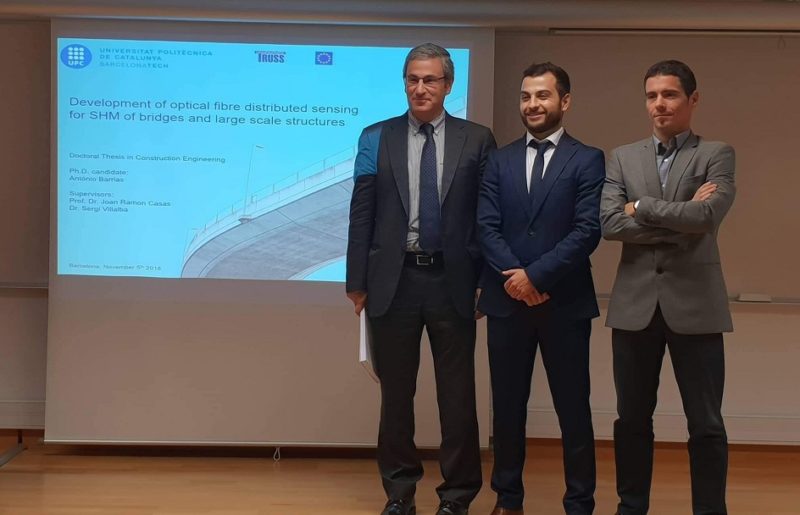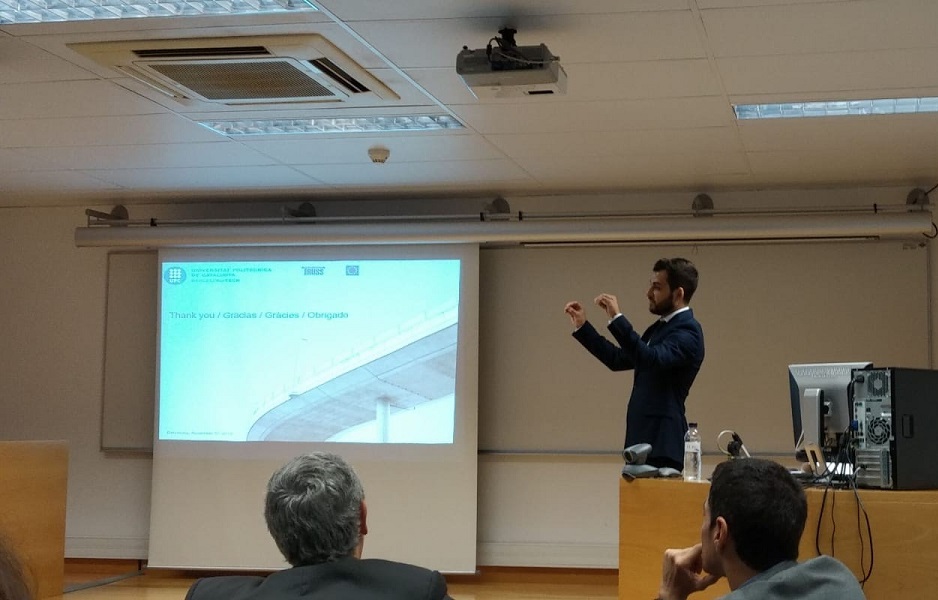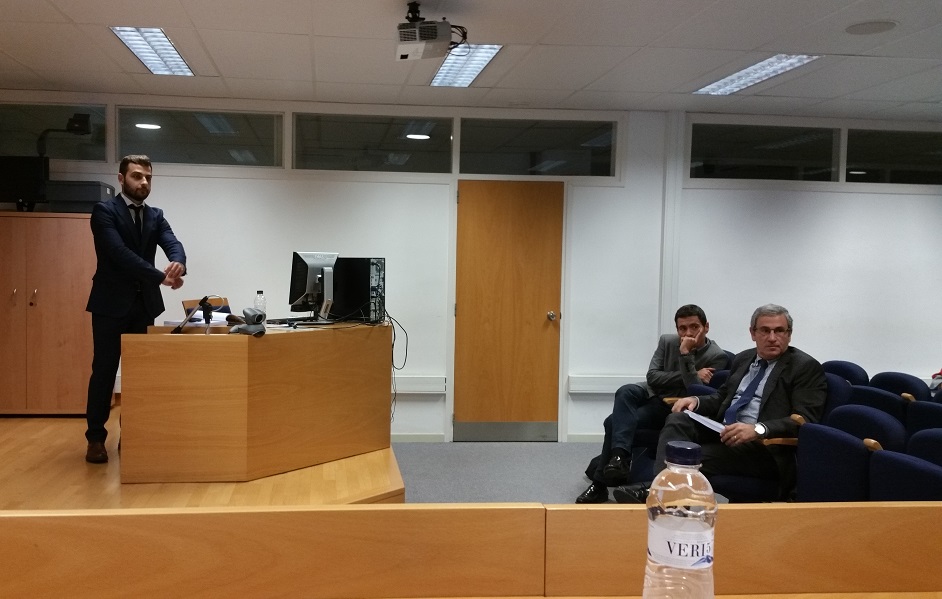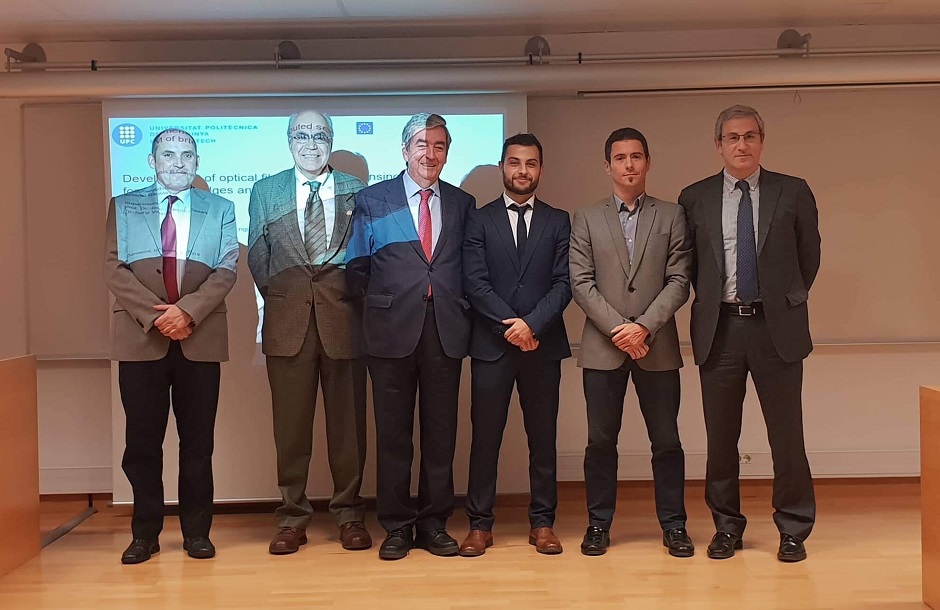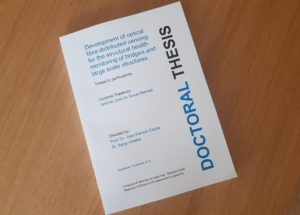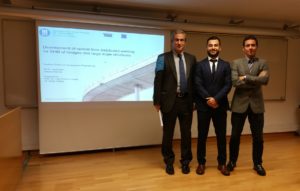on 5th November 2018, Antonio Barrias (ESR11) became the first TRUSS ESR in defending his doctoral thesis in front of a jury appointed by the Doctoral Committee of the Technical University of Catalonia (UPC). The thesis, titled “Development of optical fibre distributed sensing for the structural health monitoring of bridges and large scale structures” and directed by Prof. Dr. Joan Ramon Casas from UPC and Dr. Sergi Villalba from COTCA, was submitted in September 2018, following three years of intensive doctoral training and research with TRUSS. The public defense was held in room C1002 of the School of Civil Engineering of Barcelona, C. Jordi Girona, 1-3, Building C1 Ground Floor (Campus Nord UPC). The jury was composed by Angel Carlos Aparicio Bengoechea (President, Catedratico from UPC), Arturo Gonzalez (Secretary, Associate Professor from University College Dublin, Ireland), Michel Ghosn (Member, Professor from the City University of New York, USA), Jose Turmo (Substitute member, Professor from UPC) and Ignacio Javier Paya (Substitute member, Professor from Universidad Politécnica de Valencia).
The defense started at 12 am with a presentation in English language by Antonio where he reviewed the research carried out, the methodology used, the thesis content and specially the original contributions stemming from the research, and the conclusions and research to be carried out in the future. Once Antonio presented the thesis in about one hour to an audience of near 20 people including supervisors, jury, researchers, academic staff and Antonio’s relatives and friends, the members of the panel congratulated the candidate and supervisors for the work, and posed questions and requested clarification of points they deemed necessary. The secretary announced that those present who could demonstrate that they hold a PhD could also put forward questions. Once the defence and the discussions were over, and the audience had left the room, each of the members of the examination panel put forward, in the form of a standard document, their individual assessment of the thesis, to be appended to the Doctoral Student Activity Report. The overall mark can be: ‘Unsatisfactory’, ‘Satisfactory’, ‘Good’ ‘ or Very Good’, which is then recorded in the official examination results that all the members of the panel had to sign. All members agreed that the thesis was of the highest standards, that it represented a very significant contribution to the field of Structural Health Monitoring, and that Antonio had defended its contents very convincingly. Before adjourning the session, the chair verbally communicated the awarded mark of ‘Very Good’ to Antonio and to the rest of the people present. Given that the global mark awarded was ‘Very Good’, the members of the panel decided to propose a cum laude distinction by secret ballot (forwarded to the Doctoral Studies Committee following regulations), where they had to state the reasons for this decision: i.e., a significant advance in the state of knowledge, accredited by publications in indexed journals of proven relevance in the field (e.g. JCR indexed journals), approval of the contributions by the scientific and academic community, accredited by the dissemination of results at leading conferences in the field, and other reasons related to its scientific relevance, socioeconomic impact or patenting. The Doctoral Studies Committee then counted the votes and in accordance with Article 14.7 of Royal Decree 99/2011 of 28 January, which regulates official doctoral degree courses, decided to award Antonio with a mark of Excellent Cum Laude.
- From left to right: Joan Ramon Casas, Antonio Barrias and Sergi Villalba
The contributions of the thesis can be divided into three main parts:
- Part I is the most theoretical contribution of the thesis where the types of Optical Fiber Sensing (OFS), the principles behind them and their civil engineering applications in geotechnics, dams, pipelines, bridges, wind turbines, etc., are reviewed. The advantages of having one single continuous sensor (as opposed to multiple discrete sensors) are highlighted. An argument is made in favour of Rayleigh Backscattered Reflectometry (OBR) DOFS because they provide a continuous strain reading with the best spatial resolution (mm level), which is ideal for detection of small cracks (This work has been published in Sensors journal in May 2016).
- Part II is focused on lab tests in a controlled environment where a reinforced concrete beam is subjected to two types of tests to check and validate the performance of DOFS compared to conventional strain gauges with different bonding adhesives.
- Part II-(a) (this work has been partially published in Sensors journal in March 2018 and the remaining of the research has been submitted to Structural Control and Health Monitoring journal). A 3-point load static test is carried out. It is noted the importance of reaching a compromise between the bond-strain transfer and the coating protection to the sensor. Four different adhesives are tested with silicone performing best (i.e., smoother strain response) in an uncracked situation. Silicone had only been used as a protective coating before and this is the first know application as adhesive in this context. For a cracked situation, results can be erratic, and a Spectral Shift Quality (SSQ) approach is proposed to remove points showing anomalies and replacing them via interpolation instead. It is worth to note that in these tests, it is not only the concrete surface that is instrumented (with the challenge of the heterogeneity of the concrete), but the rebar without any mechanization, which is unique.
- Part II-(b) (this work has been submitted for publication to Smart Structures and Systems journal). Here a fatigue test is carried out on a reinforced concrete beam based on 2 million cycles and stress ranges from a real bridge. A deviation appears as a result of cracking that is corrected subtracting values at the pre-cracking stage.
- Part III. Testing of DOFS-based SHM in two full scale structures (This work has been published in Structure and Infrastructure Engineering in February 2018). It demonstrates the feasibility of implementing the system for long periods on site in:
- Part III-(a). A historic masonry building where strains are measured with DOFS installed on vaults during 18 days when rehabilitation works took place. It allows visualizing the impact of removing supports and adding temporary props, and finally putting the final columns in place on the strains at the vault.
- Part III-(b). A prestressed concrete bridge that is subjected to a widening of the deck. Strains are measured with DOFS during 6 months. It is shown how changes in temperature due to seasonal variations are captured by the system, and although significant, they can be separated from other mechanical effects.
The contents of the thesis in regard to novelty/originality, validation and significance of the contributions clearly meet the standards required for a doctoral degree. The published journal papers are evidence of the value of this research for future applications in SHM of civil infrastructure. The format of the thesis was in the form of a compendium of papers. It included 3 papers that had already been published in prestigious journals with high JCR impact and 2 papers submitted for journal publication that are under review (one has currently been accepted). During the time in TRUSS, in addition to the papers included in his thesis, Antonio has published one more journal paper, one book chapter and twelve conference papers, one of which has been invited in an extended version to a special issue of another journal. A great success and a truly remarkable achievement in a period of only three years.




